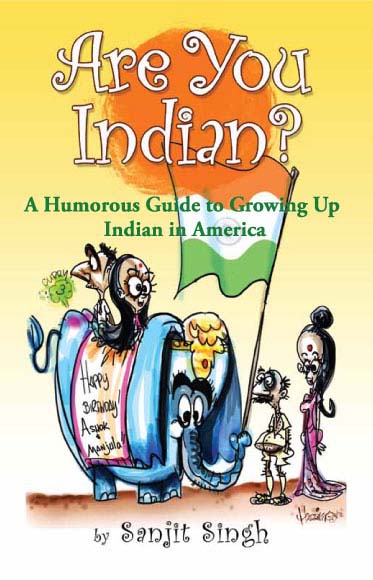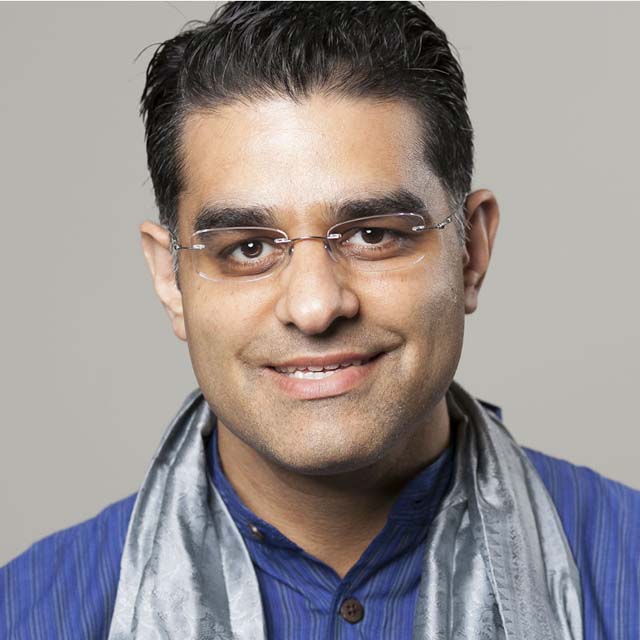
No Elephants but Yes, We’re Indian!
Does your family try to smuggle Tupperware containers filled with daal chaval into Disneyland?
Do your parents have drawers full of ketchup packages from McDonalds?
Do your parents yell into the phone even when they are not calling India?
Does your family own a Toyota or a Honda?
If you answered yes to any of these questions, then you are definitely, really, Indian! These are part of a quick quiz by light-hearted, tongue-in-cheek ‘anthropologist’ Sanjit Singh whose book ‘Are You Indian?’ is a humorous look at growing up Indian in America. Singh checks out the Indian-American phenomenon right from infancy where the little bachas are being already prepped for the spelling bee by their anxious and ambitious parents to SAT and College Admission, right on to the traumas of finding a mate.
Are You Indian? Indian Uncles, Aunties and More
Sanjt Singh has an MBA from the UCLA Anderson School of Management and lives in San Diego. He’s an entrepreneur and a speaker and contributes to the humor blog Bad Swami. This is his first book, and yes, there is a testimonial from the author’s mother. “This book is a disgrace! Sanjit should have been a doctor!”
In ‘Are You Indian?’ you are bound to find many anecdotes which resonate in your own life, and you realize Indian families all have the same dreams, the same issues and very often, the same cast of colorful characters from immigrant parents to Indian uncles and aunts. In a chapter devoted to Indian uncles, Singh proclaims that Indian uncles are the world’s worst dressers – and he’s probably right. Just think back on your own portfolio of zany uncles and aunts!

Inside the Desi Household
Singh presents a clear picture of an Indian household. “When pulling up to the driveway, you will usually see a Honda, a Toyota, or one of each. Wealthier homes have two Mercedes Benzes with personalized license plates that say something like, ‘KRISHNA1’ and ‘KRISHNA 2’. All cars owned by Indians have a box of tissues and a towel in the trunk. No one knows why.
As you enter the home, you will notice about 30 pairs of shoes in the entryway, which usually prevent the door from being opened. You’ll open the closet to hang up your coat and notice that inside the closet is a full ‘pop up mini mandir that allows a quick, convenient ‘drive-by puja’ as you enter the house or leave the house. As you move past the closet, you’ll enter a living room with uncomfortable furniture. You’ll be admonished to stay off these mid-century gems which are covered in plastic. The rule is you don’t get to use the ‘nice’ furniture or ‘pee-lates’ (plates) except when ‘reweird’ (revered) guests visit. ”
Indians’ Spelling Bee Nation
From matrimonial sites to the Big Indian Weddings to ABCDs and FOBs, nothing in the Indian-American lingo escapes Singh’s sharp eye or funny bone – and he’s generally on the mark. He writes, “I guarantee you that across town, there is a kid named Abhijit who is practicing his spelling during dinner, after dinner and on weekends. While you are playing X-Box, his parents are making him spell ‘succeedaneum’ both forwards and backwards, provide the Latin and Greek origins, and recite the definition.”
While you may not agree with Singh’s verdicts on Bollywood films or Indian sweets, you still can smile at them, and you will learn new terms such as ISG – Indian Social Gathering and all that goes on at one of these – and of course, the Indian Goodbye which goes on forever. Also tips on inventing Punjabi nicknames. “To come up with a Punjabi nickname, pick any consonant and add the suffix “-ikku”, “-oopi”, or “-inku”. Examples include Tikku, Bicku, and Pinku.”
‘Are You Indian’ is a good read and gets you a few chortles and chuckles. And what’s better than being able to laugh at yourself?
Growing Up Indian: 6 Questions for Sanjit Singh
1. What part of India are your folks from and did you grow up in the US?
My father grew up in Birmingham, England, and my mother grew up in pre-partition Pakistan and post-partition India (UP). My parents’ marriage was arranged in India after which they lived in India and then in the UK where my two older brothers were born. The four of them eventually moved to the San Francisco Bay Area where I was born and raised.
So, although I am technically a first generation Indian American, I am really a second generation westerner since my Dad was first generation Indian British. So, growing up, I did not feel Indian, I certainly did not feel American, and I did not even feel like a “normal” Indian American. I felt like an outsider in every sense of the word, especially in the 1970s when there were far fewer Indians the Bay Area than there are today.
2. Did you always see the humor in growing up Indian or was it something of a defense mechanism growing up brown in a white world?
I wish I saw the humor back then but I was self-conscious, horribly awkward, and overly preoccupied with being different. I was also not very good in school and suffered from what they would today probably describe as severe ADHD, but they were not very aware of this affliction back then or how to deal with it. So my childhood felt like a struggle culturally, socially, and academically.
I think by the time most of us are in college, we begin to better appreciate our family heritage and start to see the two cultures we straddle a bit more objectively. I think that’s when the humor begins to blossom…long after the “tragedy” is over. Now that I’m in my 40s, I see my relatively mild suffering as a child as quite humorous. My child self would probably hate my current self for laughing so hard at my child self.
3. Do you think Indian children have it easier now?
Generally, yes. I enjoy the fact that it has become “more cool” to be Indian, aided by celebrities like Aziz Ansari, Mindy Kaling, and Archie Punjabi. These three, for example, are part of great TV shows and not playing horrible stereotypical Indian characters. I can’t believe the number of TV shows where this is the case, these days. Also, India’s meteoric economic ascent on the world stage has created a lot more interest in and respect for Indian culture.
4. What’s a typical day for you and the entrepreneurial work that you’re involved with?
I have two companies that are focused on business development, sales, and marketing. One is in the shipping business and the other is in the language services business. Essentially I am a middle man and focus my time on getting and servicing both private commercial as well as government contracts and I outsource all the work to vendors. So my typical day is calling and meeting with decision makers, closing business, and ensuring that contracts are serviced properly. Now, my typical day also includes promoting this book which has been both fascinating and fun!
5. What kind of a response have you had for ‘Are You Indian?’
Quite positive. So far, people seem to find it funny and enjoyable and have been very kind with their reviews on Amazon. Two things have surprised me a little. First, my family both in the US and India enjoyed reading my work though I tease them relentlessly in the book. Second, I’ve had people from many different cultural and ethnic backgrounds tell me they really enjoyed the book. I footnoted extensively throughout the book to ensure that my stories were accessible for anyone and am very gratified that non-Indians have been able to follow along and have fun.
6. While Indian parents (uncles and aunties too) have their peculiarities, what do you think are their strengths?
I think Indian Uncles and Aunties, on balance, teach their kids great values. Many of them teach their children to work hard, get as much education as they can, appreciate everything they get, be frugal, and make their family a priority.

1 Comment
Thanks for this awesome article! I hope you all enjoy the book! Happy Holidays!
Sanjit Singh